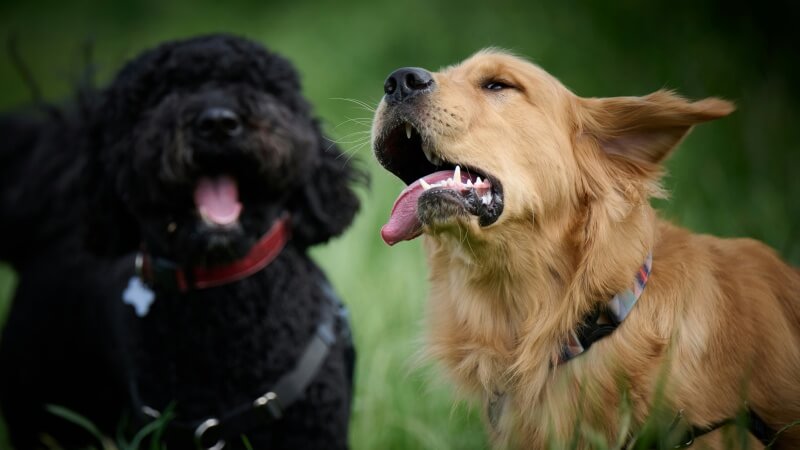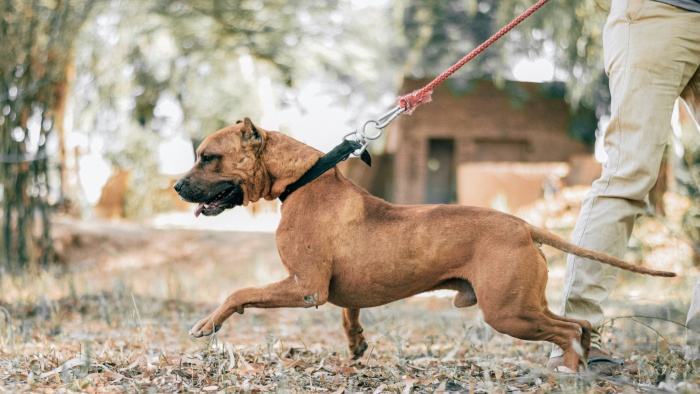How To Stop Your Dog From Barking At Other Dogs

Understanding how to stop your dog from barking at other dogs is crucial, as barking is a natural form of communication. They use it to grab attention, alert to possible dangers, or simply to let out stored energy.
This guide will show you effective ways to manage your barking, ensuring it doesn’t lead to any stress.
Through identifying what triggers their barking and implementing appropriate training techniques, you can teach your dog when it’s appropriate to bark and when to be quiet, maintaining a peaceful atmosphere for everyone involved.
Understanding dog barks
You’re likely aware that your dog employs various barks to communicate.
There’s the attention-seeking bark. This sound is made when you’ve exited the room, or they’re indicating it’s time for a bathroom break.
An excited bark is heard when they greet their favorite dog friend or you’re returning home from work. You might notice smaller yaps interspersed with these barks!
A deeper, warning bark is used to deter potential intruders or to signal something unsettling them (even if it’s merely a shopping bag caught in the wind). This can manifest as a lone bark or a sequence of anxious barks that might escalate in intensity.
Different breeds exhibit specific barking behaviors; some are inherently more vocal, while others have a distinctive bark (have you ever searched for ‘talking huskies’ on YouTube?). Meanwhile, certain dogs like the basenji don’t bark at all, preferring to yodel or howl instead. Yet, basenjis still communicate effectively, just without traditional barking.
You can often understand your dog’s message from their bark, even if you’re in another room.
If your dog’s barking has become a problem, identifying the root cause is the first step.
- Could it be that they’re lacking sufficient exercise?
- Maybe they’re bored and soliciting play?
- Possibly reacting to pedestrians near your residence?
- Could separation anxiety be the issue?
- Is it a matter of not getting enough attention from you?
- Are they signaling other dogs to keep their distance?
- Or have they conditioned you to respond to their every bark?

Why dogs bark at peers
When your dog barks at other dogs (regardless of the absence of aggression), it might indicate anxiety. Remember, your understanding that your dog’s bark signals play doesn’t necessarily translate to the other dog’s owner. A bark from an unfamiliar, especially larger, dog can feel threatening and is generally considered bad manners. Here are a few reasons why your dog might be vocalizing at another dog:
- Your female dog could be in heat, causing her to feel uneasy and irritable.
- Your dog might have undergone a recent traumatic event and feels apprehensive around other dogs.
- Your dog is acting out of a sense of protection for you, which could intensify under certain conditions such as pregnancy, unfamiliar routes, or walking in low light post-daylight savings.
- Your dog is bored with the repetitiveness of the walk and is expressing frustration.
- Your dog could be irritable or anxious due to a health issue, like arthritis or cognitive decline.
- Your dog senses or hears something elusive to you, perhaps a creature hiding in the underbrush or darting through the trees, igniting their chase instinct right as another dog passes, claiming, “I noticed it first, it’s mine!”
However, barking at other dogs isn’t exclusively a sign of hostility.
It might also stem from excitement. Your dog may have learned that barking draws your attention and attempts to apply the same tactic to engage other dogs. They’re essentially barking out an invitation to play, unable to convey their message to those dogs except through eager barks that shout, “hey, let’s have some fun together!”

Strategies for quieting your dog around other canines
To begin, let’s cover what you should avoid doing:
- Scolding your dog isn’t effective; it can stress them out and, ironically, amounts to a form of attention.
- Resist the urge to approach the other dog; instead, proceed calmly along your intended path. Should your routes intersect, attempt a 90-degree detour (where possible) and position yourself between your dog and the focus of their barking.
- Avoid yanking on the leash if your dog halts. Wait until the other dog has passed before moving on.

Now, for the proactive steps:
- For dogs that bark continuously, swiftly divert their attention. Positioning yourself between your dog and the source of their barking not only obstructs their view but also reinforces your leadership role.
- Aiming for a more long-term solution, you might train your dog to retreat behind your legs upon sighting another dog, particularly useful if their barking stems from a protective instinct. This technique reinforces the notion that you’re in charge of safeguarding both of you.
- Dismiss the barking until there’s a break in the noise.
- Focus your attention on your dog once they cease barking.
- When they halt barking, introduce a different activity. Summon them, instruct them to sit or lay down, followed by a treat. The reward is for obeying your command, not for barking.
- Anticipate the bark! If you notice pre-bark behaviors, that’s the moment to engage them in an alternate action. Rewarding them when they comply and remain calm reinforces the desired behavior for earning positive attention.
- Enhance their training in environments where they can observe other dogs from afar. Encourage engagement and play with you, overlooking the other dogs; applaud and treat them for their focus and compliance.
- Maintaining your dog’s focus during walks strengthens your bond and promotes positive behavioral patterns.
Addressing aggression in dogs towards their peers
If your usually calm dog starts showing aggression towards other dogs, it’s vital to consider that there might be a hidden reason for this change. They could be experiencing pain or discomfort, which lowers their patience level, especially around energetic puppies and younger dogs.
It’s also possible they are reacting to a female in heat nearby, leading to increased aggression among male dogs, or they might be suffering from a health condition like dementia. An unexpected shift in behavior warrants a visit to your veterinarian for a thorough examination.
What steps can you take if aggression isn’t linked to a health concern? If your dog persistently growls at other dogs they encounter (and it’s not just because of a past incident with a specific dog; remember, dogs have long memories), consulting your vet for a referral to a canine behavior expert is a prudent move.
Many professionals believe that nearly all negative behaviors can be corrected with proper training, especially for aggression that has gradually emerged. Engaging a skilled behaviorist can be invaluable, so there’s no need to feel overwhelmed if your dog has recently started displaying aggressive behaviors.
Teaching your dog the “watch me” command
Even well after your dog has mastered basic training, it’s easy to overlook the importance of ongoing obedience. Introducing new tricks not only engages their brain but also strengthens your relationship and reasserts your leadership. A quick review of basic commands can be particularly comforting for anxious dogs and a productive way to channel the energy of more vivacious ones.
For dogs prone to barking at distractions, the ‘Watch Me‘ command can be incredibly effective. It diverts their attention from whatever they’re barking at, redirecting it towards you, reinforcing your position as their leader.
You’ll need some enticing treats (while our training treats are favorites, a little shredded chicken can do the trick) and a calm environment for practice. Begin by holding up the treat to draw your dog’s gaze away from your face. Naturally, they’ll focus on the treatment initially, but your goal is to achieve eye contact.
The moment your dog looks at your face, says your chosen praise phrase (‘well done’, ‘good job’, or ‘yes’) and offers the treat. The quicker this is done, the better they’ll understand the connection between their action and the reward.
After several repetitions without the command, introduce it – this could be ‘Watch me’ or ‘Look’ (pick a phrase your dog isn’t familiar with). As you lift the treat, say the command and continue to praise as your dog makes eye contact. Through consistent training, your dog will learn to look into your eyes on command.
This technique is an excellent strategy for keeping your dog’s focus away from other dogs, including those less inclined towards play (and yes, even Barney).
Sum up
understanding how to stop your dog from barking at other dogs plays a pivotal role in nurturing a harmonious relationship between your pet, yourself, and the wider community.
This guide has explored various strategies, from identifying the triggers of your dog’s barking to implementing training techniques that encourage appropriate behavior.
Emphasizing obedience, introducing commands like ‘Watch Me,’ and ensuring your dog’s physical and mental needs are met can significantly reduce unwanted barking.
By fostering a calm and understanding environment, you empower your dog to communicate in a more subdued manner, enhancing the well-being of everyone involved.
Whether it’s through redirecting their focus, reinforcing your bond, or seeking professional advice for underlying aggression, the key is patience and consistency.
Remember, each step taken towards understanding and addressing the reasons behind your dog’s barking at other dogs is a step towards a more peaceful and enjoyable companionship.
FAQs
What initial steps should I take if my dog starts barking at other dogs during walks?
Before considering training techniques, ensure your dog’s basic needs are met. This includes sufficient exercise, mental stimulation, and checking for any health issues that may be causing discomfort or pain. Addressing these fundamental needs can often reduce instances of barking.
Can changing my dog’s walking route reduce their barking at other dogs?
Yes, altering your walking route can help if your dog is barking due to boredom or territorial behavior. Exploring new environments can provide mental stimulation and reduce the predictability that may lead to frustration and barking at other dogs.
How effective is positive reinforcement in correcting barking behavior?
Positive reinforcement is highly effective in training dogs to stop barking at other dogs. Rewarding your dog for quiet behavior or for following commands like ‘Watch Me’ encourages them to repeat these desired behaviors instead of barking.
Are there specific signs that indicate my dog is about to bark at another dog, and how can I intervene?
Yes, dogs often display certain body language before barking, such as stiffening, fixating on the other dog, or growling softly. Recognizing these signs allows you to intervene early, either by redirecting their attention or using commands to maintain focus on you.
Should I consult a professional if my dog’s barking at other dogs doesn’t improve?
If after implementing the strategies outlined, your dog’s barking persists or if it escalates into aggression, consulting a professional dog behaviorist is advisable. They can offer tailored advice and training techniques specific to your dog’s needs.

